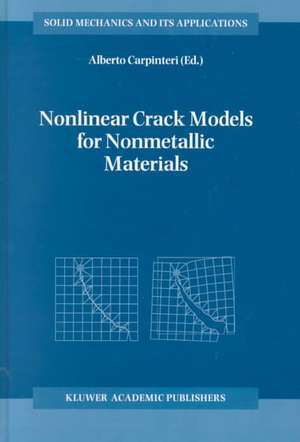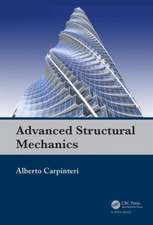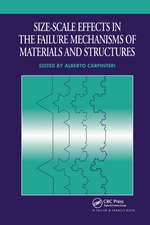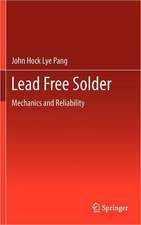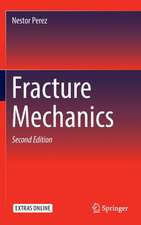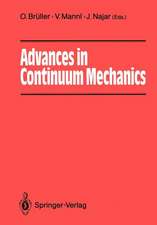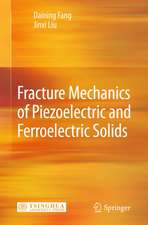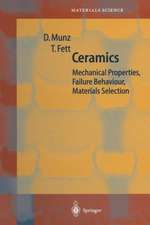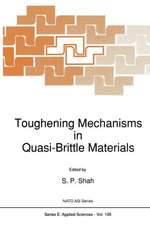Nonlinear Crack Models for Nonmetallic Materials: Solid Mechanics and Its Applications, cartea 71
Editat de Alberto Carpinterien Limba Engleză Hardback – 30 iun 1999
This volume will be of interest to students, professionals and researchers in the field of nonlinear fracture mechanics.
| Toate formatele și edițiile | Preț | Express |
|---|---|---|
| Paperback (1) | 946.24 lei 6-8 săpt. | |
| SPRINGER NETHERLANDS – 16 oct 2012 | 946.24 lei 6-8 săpt. | |
| Hardback (1) | 952.26 lei 6-8 săpt. | |
| SPRINGER NETHERLANDS – 30 iun 1999 | 952.26 lei 6-8 săpt. |
Din seria Solid Mechanics and Its Applications
- 20%
 Preț: 698.10 lei
Preț: 698.10 lei - 24%
 Preț: 800.16 lei
Preț: 800.16 lei -
 Preț: 402.14 lei
Preț: 402.14 lei - 15%
 Preț: 640.06 lei
Preț: 640.06 lei - 15%
 Preț: 653.14 lei
Preț: 653.14 lei - 18%
 Preț: 1124.92 lei
Preț: 1124.92 lei - 15%
 Preț: 643.84 lei
Preț: 643.84 lei - 18%
 Preț: 1119.38 lei
Preț: 1119.38 lei - 20%
 Preț: 573.20 lei
Preț: 573.20 lei - 18%
 Preț: 1607.92 lei
Preț: 1607.92 lei - 17%
 Preț: 393.72 lei
Preț: 393.72 lei - 17%
 Preț: 459.41 lei
Preț: 459.41 lei - 18%
 Preț: 959.98 lei
Preț: 959.98 lei - 18%
 Preț: 747.71 lei
Preț: 747.71 lei -
 Preț: 388.55 lei
Preț: 388.55 lei - 18%
 Preț: 787.15 lei
Preț: 787.15 lei -
 Preț: 406.25 lei
Preț: 406.25 lei - 15%
 Preț: 639.08 lei
Preț: 639.08 lei - 24%
 Preț: 784.84 lei
Preț: 784.84 lei - 15%
 Preț: 643.34 lei
Preț: 643.34 lei - 18%
 Preț: 958.07 lei
Preț: 958.07 lei - 18%
 Preț: 1228.15 lei
Preț: 1228.15 lei - 18%
 Preț: 734.27 lei
Preț: 734.27 lei - 18%
 Preț: 1233.06 lei
Preț: 1233.06 lei - 18%
 Preț: 1236.19 lei
Preț: 1236.19 lei - 18%
 Preț: 950.96 lei
Preț: 950.96 lei - 18%
 Preț: 906.48 lei
Preț: 906.48 lei - 18%
 Preț: 964.54 lei
Preț: 964.54 lei - 20%
 Preț: 995.75 lei
Preț: 995.75 lei - 18%
 Preț: 953.65 lei
Preț: 953.65 lei - 18%
 Preț: 1239.67 lei
Preț: 1239.67 lei - 18%
 Preț: 962.35 lei
Preț: 962.35 lei - 18%
 Preț: 964.54 lei
Preț: 964.54 lei - 18%
 Preț: 913.11 lei
Preț: 913.11 lei - 18%
 Preț: 1226.90 lei
Preț: 1226.90 lei
Preț: 952.26 lei
Preț vechi: 1161.29 lei
-18% Nou
Puncte Express: 1428
Preț estimativ în valută:
182.27€ • 198.06$ • 153.21£
182.27€ • 198.06$ • 153.21£
Carte tipărită la comandă
Livrare economică 21 aprilie-05 mai
Preluare comenzi: 021 569.72.76
Specificații
ISBN-13: 9780792357506
ISBN-10: 0792357507
Pagini: 309
Ilustrații: XI, 309 p.
Dimensiuni: 155 x 235 x 19 mm
Greutate: 0.64 kg
Ediția:1999
Editura: SPRINGER NETHERLANDS
Colecția Springer
Seria Solid Mechanics and Its Applications
Locul publicării:Dordrecht, Netherlands
ISBN-10: 0792357507
Pagini: 309
Ilustrații: XI, 309 p.
Dimensiuni: 155 x 235 x 19 mm
Greutate: 0.64 kg
Ediția:1999
Editura: SPRINGER NETHERLANDS
Colecția Springer
Seria Solid Mechanics and Its Applications
Locul publicării:Dordrecht, Netherlands
Public țintă
ResearchCuprins
1. Introduction.- 1.1. Preliminary Remarks.- 1.2. Irwin’s Plastic Zone.- 1.3. Dugdale-Barenblatt Cohesive Zone.- 1.4. Stability of a Bridged Crack.- 1.5. Microcracked Zone ahead of a Macrocrack Tip.- 1.6. Final Remarks and Bibliographical Guide of the Author’s Contributions to the Subject of the Volume.- 1.7. References.- 2. The Damage Crack Model.- 2.1. Introduction.- 2.2. Strain Energy Density Criterion.- 2.3. Mode I Problems.- 2.4. Mixed Mode Problems.- 2.5. Size Effects on Strength and Ductility.- 2.6. References.- 3. The Cohesive Crack Model.- 3.1. Introduction.- 3.2. Basic Concepts of the Cohesive Crack Model.- 3.3. Mode I Problems.- 3.4. Mixed Mode Problems.- 3.5. References.- 4. The Bridged Crack Model.- 4.1. Introduction.- 4.2. The Discontinuous Bridged Crack Model (Single Reinforcement).- 4.3. The Discontinuous Bridged Crack Model (n Reinforcements).- 4.4. The Continuous Bridged Crack Model.- 4.5. Applications of the Bridged Crack Model in Structural Analyses.- 4.6. References.- 5. The Microcrack-Interacting Model.- 5.1. Introduction.- 5.2. Microcracking in Brittle Solids.- 5.3. A Semi-analytical and Numerical Approach to Crack Interaction Problems.- 5.4. A LEFM Mesoscopic Approach to Macrocrack-Microcrack Interaction Problems.- 5.5. Small-Scale Microcracking in the Process Zone.- 5.6. An Energy Approach to Interactive Phenomena.- 5.7. A Statistical Approach to Microcracking.- 5.8. References.- 6. Comparisons and Conclusions.- 6.1. Preliminary Remarks.- 6.2. Cohesive Crack Model versus Damage Crack Model.- 6.3. Bridged Crack Model versus Cohesive Crack Model.- 6.4. Evolutive Analysis of Multicracked Bodies.- 6.5. References.
